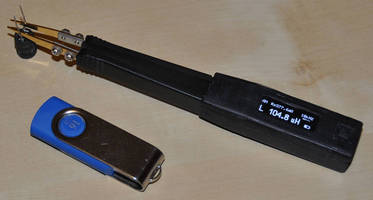Siborg Provides Sneak Peek of Soon to Be Released LCR Reader, Half the Price and Weight of Smart Tweezers LCR-meter

New simplified design features significantly reduced price and weight while still maintaining 1% basic accuracy of the new LCR- and ESR-meter
TORONTO - Smart Tweezers are the world's first handheld, lightweight LCR-meter aimed for use in Surface Mount Technology (SMT). In order to make testing and identifying components quick and easy, a patented design was implemented combining LCR-meter with tweezer probes and an LCD screen. Due to its light weight and compactness, Smart Tweezers LCR-meter can be used by just one hand, leaving the other free for other tasks. From the very beginning this was a proven successful concept, currently helping thousands of customers in virtually any country and any major high-tech company worldwide.
The main disadvantage of Smart Tweezers LCR-meter has always been a relatively high price, ranging from $300 to $700 in various countries and resellers. Some customers also criticized a bit crowded screen of the latest Smart Tweezers model ST5. All in all Smart Tweezers LCR-meter was recognized as a high quality tool for professionals, but the high price hampered its spread for hobbyists.
There were a few attempts from other companies to create a cheap version of Smart Tweezers. They were all based on Cyrustek chip, but they were all using direct current measurements and therefore missing measurement of inductance. On the other hand, the prices they offered were almost 10 times lower compared to that of Smart Tweezers; and therefore, these cheap devices have taken a significant share of the market.
There was an attempt to create a Smart Tweezers model with a lower price (that did not have a 1 Volt test signal option), but the price reduction appeared to be only about 20% and it did not change the overall market picture.
About a year ago a new Smart Tweezers development started, based on the new microchips that have become available and new ideas on how to simplify the circuit without sacrificing too much of the accuracy. As a result a working prototype of LCR-Reader has been created. It has a significantly smaller size and lower weight as well as the manufacturing cost compared to Smart Tweezers LCR-meter.
LCR-Reader is about half the weight of Smart Tweezers ST-5. It is also powered by Li-Ion battery rechargeable via a micro-USB connector. Basic accuracy of the new device is about 1%, which is about the same as that for Smart Tweezers ST-2. It also has gold-plated stainless steel tweezer tips. There is just one button that turns the device on and allows it to shuffle through different modes of operation: A (automatic), L (inductance), C (capacitance), R (resistance), and ESR (equivalent series resistance). All measurements are done automatically; test signal amplitude is 0.5 Volts, test frequency is adjusted according to the component type and value.
An example showing measurement of an inductance is where AM indicates that the measurement is made in Automatic Mode, Rs indicates parasitic series resistor of the inductance, 10 kHz is the test frequency, L indicates that the component measured is an inductance and 104.8 uH indicates the inductance value in micro-Henries, and the battery sign shows the battery charge level.
LCR-Reader is planned to be available for purchase sometime this coming summer. Estimated sales volume is about four-fold compared to the latest Smart Tweezers model ST-5. Follow the latest news at Smart Tweezers Blog. You can also watch a brief video of Smart Tweezers LCR-meter introduction.
For further information please contact:
Dr. Michael S. Obrecht, Director
Siborg Systems Inc
24 Combermere Crescent
Waterloo, Ontario N2L 5B1 Canada
Tel 519-888-9906
Fax 519-725-9522
lWeb www.siborg.com



